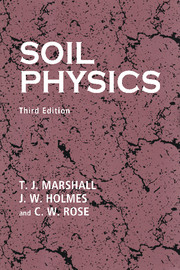Book contents
- Frontmatter
- Contents
- Preface
- Preface to the second edition
- Preface to the first edition
- 1 Composition of soil
- 2 Interaction of soil and water
- 3 Measurement of water content and potential
- 4 Principles of water movement in soil
- 5 Distribution of water in soil
- 6 Ground water in soils and aquifers
- 7 The use of isotopes and other tracers in soil water and groundwater studies
- 8 Soil structure
- 9 Deformation of soil
- 10 Management of soil water
- 11 Soil erosion and conservation
- 12 Chemical transport in soil
- 13 The physical environment of roots
- 14 Plants and soil water
- Appendixes
- References
- Index
Preface to the first edition
Published online by Cambridge University Press: 05 June 2012
- Frontmatter
- Contents
- Preface
- Preface to the second edition
- Preface to the first edition
- 1 Composition of soil
- 2 Interaction of soil and water
- 3 Measurement of water content and potential
- 4 Principles of water movement in soil
- 5 Distribution of water in soil
- 6 Ground water in soils and aquifers
- 7 The use of isotopes and other tracers in soil water and groundwater studies
- 8 Soil structure
- 9 Deformation of soil
- 10 Management of soil water
- 11 Soil erosion and conservation
- 12 Chemical transport in soil
- 13 The physical environment of roots
- 14 Plants and soil water
- Appendixes
- References
- Index
Summary
This book is written for the scientist who works with soils, plants, or water resources, as well as for the student of soil physics. We have attempted to allow for the differing backgrounds of the soil scientist, the agronomist, the chemist, the physicist, the hydrologist, or the civil engineer, who may be concerned with soil physics, by defining a number of terms in soil science, physics, and mathematics that may seem elementary to some but can be unfamiliar to others. Similarly, we have treated units in some detail because the International System (SI) of Units that we use is not yet universally adopted in the field of soil physics. Here the differences in background are likely to be national rather than professional. To help in this we have, in many of the diagrams and tables, presented data in non-SI units as well. Units and conversion factors are listed in Appendix A. Vector notation is introduced to show the concise way in which flow equations are often expressed in the literature of soil physics, but knowledge of vector analysis is not required.
The central connecting theme is the state of water in a porous material. This is introduced early in the book in order to set out the principles of water retention that are basic to most of the topics that follow. The physical properties of soil are broadly dealt with in the opening chapter to provide an outline of the nature of the porous material with which water interacts and through which it moves.
- Type
- Chapter
- Information
- Soil Physics , pp. xiii - xivPublisher: Cambridge University PressPrint publication year: 1996



